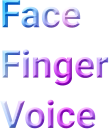


Implementation Scenarios
In most institutional and government implementations, the client already has a person information
system with various specialized functions, for which biometric person identity management is required.
Voters, Pensioners, Employees and Other Recipients of Managed Benefits
Increasingly, a need for remote person verification by biometric voice or facial identification using smart
phones, is being explored by various institutions for voters, pensioners, and in National Identity
Management Systems where registered persons may need to update personal information from remote
locations.
This requirement also comes with deployment and implementation scenarios like client-server, browser
enabled web deployment, and mobile or offline operation.
In the latter case, the Windows Forms version of the application restores the complete database or a
subset of the database to a laptop computer.
On start-up, the application will run as a client if it detects and connects to the person information
server and biometric server on any connected and configured network.
If there is no network connection to the person information server, the application will automatically
run in Local Mode. It will run a local version of the Neurotechnology biometric engine with all server
functionality, except scale and speed. In this state all inserts, updates and deletes are saved in a
temporary table from which they will be replayed on the person information server when connectivity is
restored.
If the person information server is connected but the biometric server is unreachable, the application
runs in Offline Mode. This means all biometric functions and any other functions that require biometric
identification or verification are disabled.
Features and Functions
DigitalU has functions for:
Recording and Saving common person attributes like gender, date of birth, place of birth,
nationality, names, identification numbers (social security, national ID, etc.), contact information
(phone, email, etc.), address, related persons, employment, and any other information required by
the implementation. Only one version of date of birth, place of birth, gender and nationality can
exist in DigitalU for each person. All other attributes are without limit. Each instance of an attribute
for any one person is distinguishable by type, value and unique start and or end dates where
applicable.
Names are accumulated by name type (name at birth, married name, maiden name, alias,
legal name change) and optional name date.
Addresses and marital status and employment are accumulated by date and current status.
These features allow the person information system to accumulate all required information
throughout a subject’s lifecycle.
DigitalU can store this information in its own databases or retrieve them from an existing
person information system.
Biometrically enrolling, identifying and verifying persons using face, fingerprint and voice.
Printing ID cards for any number of categories of persons using ICAO compliant photos from the
biometric system.
Contact Center Functionality incorporating phone (video and voice), email, text, chat, screen
sharing, WhatsApp Messaging and Microsoft Teams integration.
Biometric voice identification and verification of incoming and outgoing callers on remote voice
channels
Performing all these functions on a central server or offline on a mobile device disconnected from
the central servers. This functionality includes automated synchronization of offline data to central
server when network connection is restored.
DigitalU is a hybrid Windows application capable of running as a windows client connected to a
database server and a biometric server on a Local Area or Wide Area Network; as a mobile
application with its own portable local database, and local biometric server; and as a web
application on any HTML 5 compliant web browser, over any TCP/IP network.
Deployment:
To fit various deployment scenarios without modification, DigitalU is fully network aware and can
automatically function in all these modes solely on the basis of its admin-user defined configuration.
When correctly configured for your network environment the system will automatically connect to
servers on a LAN or WAN; or operate in Local mode when servers are unreachable on a network.
Environmentally Responsive Operation
On LAN
On startup, DigitalU first pings the LAN person information database server in its configuration file. If the
LAN server responds the system defaults to LAN operation. This is the mode of operation when DigitalU
is run on a web server from a browser. This web scenario assumes that the web server, and person
information database server are both on the same local area network or same server.
On Line
If the LAN Server is unreachable, DigitalU pings the webservice address in its configuration. If the web
service responds, it then pings the remote biometric server address. If both are reachable. The system
operates online over the Internet.
Local
If LAN servers and web services or remote biometric servers are unreachable, the system checks if a
biometric server is running on the offline computer. If no, it starts and runs a pre-configured local
biometric service on the offline computer. It then runs in local mode. This means that all biometric
enrolments, verification logs, and permissible changes to the person information database are on the
local databases in the offline computer. All changes are recorded for later synchronization when the
offline machine next connects to the LAN server.
Licensing
DigitalU and all components of DigitalU, including Neurotechnology biometric server and biometric
application software; SIP Server; Operating Systems (Microsoft Windows and Debian Linux); and
Database Server Systems (Microsoft SQL Server and PostgreSQL), come with perpetual licenses.
Data Sources and Data Access
DigitalU is a multi-tiered system with a separate data access layer capable of connecting to any data
source for which there are dot net framework or ODBC drivers on Microsoft Windows 10+ operating
systems.
DigitalU uses the following functionally distinct databases:
•
Person Information
•
Biometric Templates (face, finger and voice)
•
Face and Finger Images
•
Voice Recording
•
Documents
•
Security or Access Control
•
Users
•
Application and Database Activity Logs
All databases can run on the same server or on multiple servers, depending on operational scale and
security concerns. If the client already has these database functions in its information system, DigitalU
can be configured to connect to them. Multiple functions can be in a single database. For scalability,
resilience, maintenance and efficiency, it is recommended that biometric, image, document and log
databases be separate and when necessary, migrated to their own servers.
Usually, the Person Information database already exists. For example: the Civil Service Management
System in Liberia; or the Pension System in NASSIT. The Biometric Templates database rarely exists and
when it does, may be replaced completely. There are exceptions. In the Contract to Clean Establishment,
Members and Biometric Data in NASSIT in 2019 all required databases already existed and were
maintained; with the exception of the Documents database, which was created from scratch.
Call Centre Integration
With On Call Face and Voice Verification























